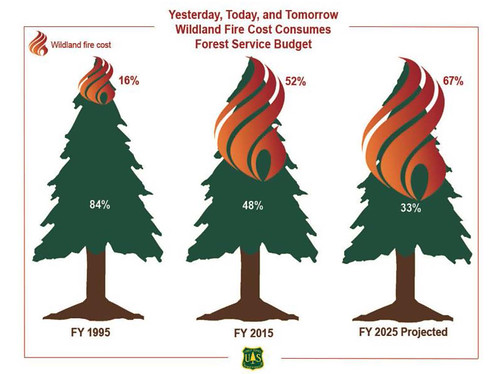
Cross-posted from the Seattle Times:
Wildfires are now burning in Washington and across the West, in a year that may become the hottest on record. As our forests go up in flames, so too does the budget of the U.S. Forest Service, putting at risk lives, property, clean air and water, and jobs for thousands.
The number of fires the Forest Service and its partners fight every year is staggering: There have been more than 36,000 fires this year alone. And although we are successful at suppressing or managing 98 percent of fires when they start, the 1 to 2 percent of fires that escape are expensive, constituting 30 percent of annual costs.
Climate change and other factors are causing the cost of fighting fires to rise every year. But the Forest Service is expected to absorb those costs into its regular budget, which remains relatively flat. This means that every year, fire grows as a percent of the agency’s budget, while all other programs shrink. A separate and compounding problem known as “fire transfer” occurs when the agency is forced to pay for fires by transferring additional funds midyear from already-depleted programs. Both elements put enormous stress on the very programs that reduce the threat of future fires.
No other natural disasters are funded this way.
To solve the problem, Congress must change the way it pays for wildfires. Any solution must confront both parts of the funding quandary: It must limit or reverse the runaway growth of fire programs as a percent of the Forest Service’s annual appropriated budget, and it must address the compounding disruption of fire transfers.
In fact, bipartisan legislation that offers a common-sense approach to funding wildfires, the Wildfire Disaster Funding Act, has already been introduced in the U.S. House and Senate and is mirrored by a similar proposal in the president’s 2016 budget. These proposals provide a fiscally responsible way to treat wildfires more like other natural disasters, end transfers and partially replenish our capacity to restore resilient forests and protect against future fires.
Under the bill, 70 percent of the costs of fire suppression are treated just as they are now — paid for out of the regular Forest Service budget. For the 1 percent of fires that account for 30 percent of total fire-suppression costs, the Forest Service could access disaster funding. This approach treats these large, expensive fires as natural disasters while allowing the Forest Service to reinvest funding in forest restoration activities that reduce the threat of catastrophic fires.

We are at a tipping point. A new report released Wednesday by the Forest Service illustrates the consequences of inaction. This year, for the first time in history, 52 percent of the Forest Service’s annual appropriated budget is going to address wildfires, compared to just 16 percent in 1995. By 2025, the share of the agency’s budget devoted to wildfires could exceed 67 percent.
In effect, the numbers mean that the Forest Service has nearly a half-billion dollars less (in 2015 dollars) than it did in 1995 to do all of the other work of the agency. There has also been a 39 percent loss of non-fire personnel, from approximately 18,000 in 1998 to fewer than 11,000 in 2015, while the fire staff has more than doubled.

This dramatic shift has real implications on the ground, undermining the very restoration projects that have been proven to reduce the risk of catastrophic wildfires in the future, along with watershed projects to protect drinking water for one in five Americans, recreation projects that support thousands of jobs and billions of dollars of economic activity, and protection for precious cultural resources and wildlife habitat.
The Forest Service has done its best to do more with less and continue to conserve the nation’s forests and meet public needs while simultaneously fighting fires and managing the risk of future fires.
But this dilemma will only get worse if left unchecked. Because the cost of firefighting is growing every year, within just ten years, two out of every three dollars the Forest Service gets from Congress will be spent on fire programs.
Paying for today’s fires by stealing from programs that reduce the threat of future catastrophic fires makes no sense. Congress should act now to fix this problem and protect the Forest Service’s ability to conserve our national forests and grasslands for generations to come.



